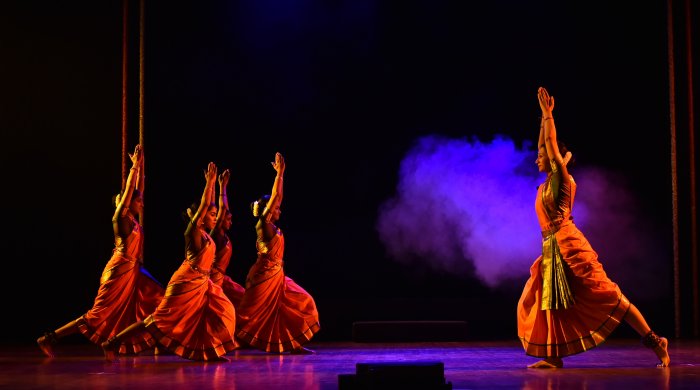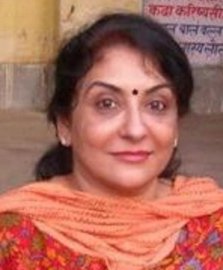
|   |

|   |
River - The Elixir traces a sacred landscape - Jyothi Raghuram e-mail: jyothi.r.ram@gmail.com Photos: Srivatsa Shandilya November 28, 2022 A confluence of spirituality, ecology, philosophical essence, with rivers as a metaphor for a nurturing life force, captured the sum substance of River - The Elixir, a thought provoking thematic presentation, which threw up existential questions. Overall, a constructive presentation, as relevant to times and a crucial issue to mull over individually. Indian ethos considers its rivers as a divine life spark, from which arose its civilization. Despite the sanctity attached to rivers, the schism between religious beliefs and rituals, and the misuse and polluting of waters (read rivers) remains a puzzling dichotomy. The legends and mythological stories attached to rivers, the significance of their conjoining (sangam), an implied meaning of looking inwards, and circa present times with its human induced abuse of rivers, encapsulated the theme. This year's event was organized at the Seva Sadan, Bengaluru.  Kalasindhu Guhyam: The sound of water and rain effects with continued movements of the flow of waters, crisp nritta highlighted by a tillana, and aided by a brief commentary helped visualise the historicity and legends attached to the ancient temples of Tirumakudalu Narasipura at the Triveni Sangam of the Cauvery, Gupta Gamini and Kapila rivers; a revelation in itself as not many know about this revered pilgrim centre, carrying the label, Dakshina Kashi. Times are changing. New themes are continued to be experimented with. To connect them contextually makes for their relevance; the pitfalls lie ironically in their novelty. The creative ability to make them stand alone pieces that can appeal to an initiated audience is the challenge of such choreography. Clarity in tracing the history of Tirumakudalu to Agastyamuni, particularly in an angry Hanuman chopping off the top of the sand linga consecrated by Agastyamuni; the presence of water atop the linga since then, believed to be Ganga; the Hanuma linga temple, with its linga later consecrated by Hanuman, and the serene appeal of the region were well glorified in Poornima Gururaja's attempt, which looked at presenting the theme at a graspable level. The origin of the Gunja Narasimhaswamy temple, where the Lord appears in the dream of a washerman, asking for a temple to be built for him, made for an interesting episode. Fresh ideas aplenty in building up the theme, easily comprehensible, coherent verbalization, clear visualization of the concept, neat symmetry of dancers was Guhyam in totality. Poornima Gururaja's ideas connected well with the audience. Flaunting the names of well-known sculptor Kanaka Murthy and legendary violinist T. Chowdiah as hailing from this beautiful, auspicious place, but most neglected by officialdom, was ingenuous, bridging to present times. A well-deserved compliment to Poornima and her Kalasindhu team of dancers. However, showing waves of water repeatedly revealed a constriction in imagery, making the rhythmic aspects appear rather simplistic; the commentary at times dominated in communicating. The live music, led by Poornima on the cymbals, vocal (Rohith Bhat Uppoor), G Gurumurthy (mridangam), Mathur Srinidhi (violin), and Karthik Vydhatri (rhythm pads), expectedly made all the difference to the appeal of Guhyam.  Padmalaya Organising thematic dance programmes, that too inviting other acharyas to translate such topics effectively, is challenging including in coming out with worthwhile subjects for nineteen years, annually. Padmalaya Dance Foundation of Guru Padma Murali takes credit for organising such presentations under the banner of International Dance Alliance India. Adi Shankara was central to the theme and characterization of Namami Narmade, the heart-touching conversation between Ma Narmada and Shankaracharya weaving through periods of time the river has experienced, her very origins, as Shankaracharya searches for a Guru. The inspiring refrain of Chidananda Rupam was certainly a clincher, even as the pancha boothas, pancha dhaatus et al were attempted to be connected to the meandering journey of human life. Lofty at its core, it was not merely a philosophy that was mouthed. Upbeat and neat were the dancers, their synchronization vouching for firm grounding. An important aspect of the costuming was that the feet were visible for one to assess the footwork of the dancers. And it was worth the while. The otherworldly dimensions of human life against the backdrop of the timeless flow of the Narmada, was well narrated. Janani Murali came across as a serious dancer, immersing herself in what she was portraying. What took away from the lingering mood of each scene was the abrupt ending of the recorded music, which cut into the flow, although it was no reflection on the quality of the music. Vasudha Balakrishnan was credited with the music composition and vocal, Karthik Datar (nattuvangam and rhythm pad), Srihari Rangaswamy (mridangam), Narasimha Murthy (flute), Gopal Venkatramana (veena), Keerthi Kumar (lighting) and the dialogues in English by Janani that was crystal clear sans an artificial accent, which can be a perfect put off. Aninditha Ashok, Poshini Zunjarwad, Niveda Balaji, Anusha Kiran and Sahasra Jayanth besides Janani comprised the professional Padmalaya troupe. The story of Ganga's descent to earth, caught in the knotted mane of Shiva to tame her turbulence, never stops fascinating one. The holiest river of India, Ganga, with her purifying waters, is believed to help mankind in salvation. Yet, her waters are most polluted, choking her existence itself. That such a nurturing river, revered by millions, could, by such callousness, one day become part of a story book, is a moot question.  Indu Venu and Shruti Gopal Rivers Reverse: The Ascent of Ganga dwelt on all these aspects via Thirike Yatra, a Malayalam poem by Murugan Kattadada, formatted as in a varnam by Shruti Gopal and Indu Venu. Recognised dancers of merit, Shruti and Indu were striking in the execution of jathis, neat and sprightly as they were. Grace and right technique were the highpoints. Children playing on the banks of the Ganga, playful elephants bathing in her waters, rubbish thrown into her mindlessly and choking her, and finally, questioning her very survival, to the elevating strains of Ganga Maam Paahi, were ideated but failed to leave an impression. The dancers did justice to the ebullient jathis of Guru Padmini Ramachandran and Guru Shobana Balachandran. Credit for the recorded music went to music composition and vocal-- Abhishek Chandrasekar, nattuvangam by Krithika Thiagarajan, mridangam by Harsha Samaga, violin by Mathur Srinidhi and flute by Mahesh Swamy.  Usha Datar and Padma Murali Guru Usha Datar was given the Leela Shekar annual award on the occasion.  Jyothi Raghuram is a senior journalist and art critic based in Bangalore. |